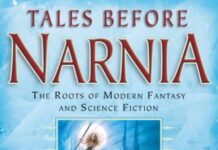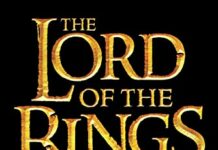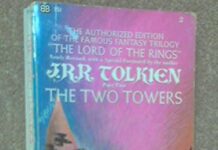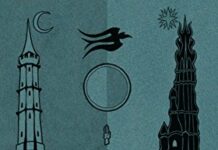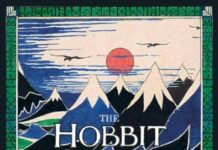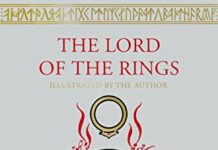
Ebook Info
- Published: 2014
- Number of pages: 449 pages
- Format: PDF
- File Size: 1.69 MB
- Authors: J.R.R. Tolkien
Description
New York Times bestseller“A thrill . . . Beowulf was Tolkien’s lodestar. Everything he did led up to or away from it.” —New Yorker J.R.R. Tolkien completed his translation of Beowulf in 1926: he returned to it later to make hasty corrections, but seems never to have considered its publication. This edition includes an illuminating written commentary on the poem by the translator himself, drawn from a series of lectures he gave at Oxford in the 1930s. His creative attention to detail in these lectures gives rise to a sense of the immediacy and clarity of his vision. It is as if Tolkien entered into the imagined past: standing beside Beowulf and his men shaking out their mail-shirts as they beach their ship on the coast of Denmark, listening to Beowulf’s rising anger at Unferth’s taunting, or looking up in amazement at Grendel’s terrible hand set under the roof of Heorot. “Essential for students of the Old English poem—and the ideal gift for devotees of the One Ring.” —Kirkus
User’s Reviews
Reviews from Amazon users which were colected at the time this book was published on the website:
⭐This is (another) posthumous collection of writings by J.R.R. Tolkien, this time largely academic, and only occasionally (and indirectly) connected to Middle Earth matters; it is published under the general title of “Beowulf, A Translation and Commentary, together with Sellic Spell,” but it actually contains a little more material than indicated.It is a must-have for *really* committed Tolkien fans, and all Tolkien scholars, and will probably be found of value to any admirers of “Beowulf” (and Old English poetry in general) who don’t already fall into the former categories. Those whose dedication to Tolkien is more limited *may* want to give it a pass, at least in its hardcover (and Kindle) incarnations — although the current prices are very attractive. (I am a little dubious about reading it on a Kindle, given that I use lots of colored place-markers, keying the commentary to the translation….). I hope that the following description, and evaluation, will prove useful to those considering purchasing it.The volume at hand contains several distinct, but related pieces, assembled by Christopher Tolkien from his father’s manuscripts (including typescript copies, which contain fewer problems with Tolkien’s notoriously difficult handwriting). It does *not* contain his published (and famous) British Academy lecture, “Beowulf: The Monsters and the Critics,” nor Tolkien’s introductory and supplemental material from C.L. Wrenn’s revision of the old Clark-Hall prose translation of Beowulf (both of which are to be found in the collection “The Monsters and the Critics, and Other Essays.”) Nor does it cover the previously-published posthumous editions of “Finn and Hengest,” (concerning a digression in the poem, and the complementary “Fight at Finnsburg” fragment), and Michael Drout’s excellent (and, alas, apparently out-of-print) “Beowulf and the Critics,” an edition with commentary of the early, and longer, drafts of “The Monsters and the Critics.” (This is not, I think, directly referenced in the present book, although I may have missed it in my rapid initial reading.)First, it contains J.R.R. Tolkien’s own prose translation of the Old English “Beowulf,” originally undertaken in the 1920s (based on the 1922 first edition of Fr. Klaeber’s great “Beowulf and the Fight at Finnsburg”), and (very) slightly revised from time to time over the following years. For the curious, this “epic poem” (a label to which Tolkien objected) consists of 3182 lines of alliterative verse (a term Tolkien also disliked, it appears), It is contained in pages 13-105. There is a set of short notes to the translation, as well (pages 107-135), as Christopher Tolkien explains how he arrived at some of the readings, where the existing copies differed, and if there was no clear indication of relative date.Second, it contains substantial-looking excerpts from Tolkien’s notes for lectures on “Beowulf” he delivered to students at Oxford in the 1930s (some of whom, at least, had available Klaeber’s third revised edition of 1936), mainly concerning the Old English text of only the first half of the poem — the part contained in the Oxford English syllabus, a practice which Tolkien disliked; and he does manage to work in some interesting discussions of the latter part also. This is found in pages 137-353; I am still working my way through it, after checking what Tolkien had to say on passages that seemed to me especially interesting, or are considered exceptionally difficult.Third (pages 355-414), it contains Tolkien’s attempt to reconstruct the “wonder tale” of the hero Bee-wolf and the monster, which he (like most others) assumed to have been combined with “historical” matter to produce “Beowulf.” Tolkien, however, offers a rendering into Old English prose, as well as the modern English version. This is the material is described in the title as “Sellic Spell” (or “wonderful story”). It is interesting reading, and provides an exercise for students of Old English as well. (Which I may test myself on someday, if I can get my Old English up to speed.)Finally, it contains two drafts of a poem, or two poems on the same subject, presenting “Beowulf” material in the style of a traditional ballad, instead of a “fairy tale” (pages 415-425), as “The Lay of Beowulf.”My first reaction is of overwhelming approval. The “Beowulf” translation has some points which I find peculiar, like the references to Dark Age Scandinavian warriors as “knights” (which for me always brings in associations of mounted warfare), and the occasional archaic spelling of a current word (Christopher Tolkien notes that he has retained the use of `corse’ for `corpse’).On the whole, however, its differences from the usual translation practices are in the direction of clarifying the syntactic and lexical issues. For an immediate example, one can turn to the opening, where “hron-rad” (line 10) is, for once, the place “where the whale rides,” instead of the commoner, simpler, but less precise, image of “the whale’s road,” which seems to restricts a whale’s freedom of movement.Although Tolkien changed his mind on some points over the years, the translation as a whole reveals how he interpreted various disputed passages; for example, that the angered dragon did not, lizard-like, ‘scuttle across the stone,’ but, doglike, “smelt now along the rock” (*stonc aefter stan*) in quest of the thief of the jeweled goblet (line 2288). (This was a standard reading of the time, reading “stonc” as a form of “stincan”; more recent editors have tended to disagree. And yes, this section of the old poem *is,* as many have recognized over the years, related to Bilbo and Smaug.)At this point in my life, however, I am so familiar with “Beowulf” in modern English garb (not to mention having long ago worked through the Old English in Klaeber’s third edition) that I may not be the best guide to how a reader fresh to the subject will experience the translation.As for the Commentary: I have so far found it impressive, and also enlightening (about “Beowulf” and about Tolkien). Then again, I’ve read several Beowulf commentaries, one of them quite recently, and a fair amount of the critical literature. The issues it deals with may not be so clear to others.The beginning student, at least the one with Tolkien mainly in mind, will probably find help in Raymond W. Chambers’ grand old “Beowulf: An Introduction to the Study of the Poem with a Discussion of the Stories of Offa and Finn,” which is one of the few critical works Christopher Tolkien mentions as helpful to the reader. It went through several editions. The original version (without the later Supplement by C.L. Wrenn) is available as a free Kindle Book. For the same type of reader I hesitantly suggest the 1922 (first) edition of Klaeber’s text and commentary, also free as a pdf on-line (see archive-dot-org, the Library-of-Congress-sponsored website), which provided the base text for Tolkien’s translation. It should be less confusing than constantly checking the variant readings and the commentary for Klaeber’s later changes in the second and third editions (although Tolkien probably had some of Klaeber’s changes and additions in mind when preparing the lectures on which this commentary is based).Klaeber revised the text, as well as expanded the commentary and bibliography, in 1931 and 1936, and the latter edition, with supplements (1950), was reprinted for the rest of the century; copies are fairly readily available used (I reviewed it some years back, when I was also dealing with some “Beowulf” translations). The commentary in the most recent form, as “Klaeber’s Beowulf: Fourth Edition,” was massively revised by the editors, R.D. Fulk, Robert E. Bjork, and John D. Niles (2008), and is an invaluable modern guide to the poem, but is of much less immediate value to the student of Tolkien. If a copy is available, Drout’s commentary in “Beowulf and the Critics” contains copious material on the older secondary literature, to which Tolkien was reacting in the 1930s. (I also reviewed the first edition of Drout-Tolkien, back when it was still in print.)
⭐Like most Americans of a certain age, I first met “Beowulf” in an English class in high school. I know exactly where I met him – in a classroom on the second floor of the school, in a textbook entitled “England in Literature.” It was an all-boys high school, so the story of Beowulf, Grendel and Grendl’s mother held our attention more than more works – we couldn’t resist lots of blood and gore, ogres eating knights for snacks, and arms getting whacked off?I ran across “Beowulf” again in college, in an English literature class my sophomore year. Being a mixed-gender class and something more serious than high school students thinking of graduation, we focused on the epic poem itself, its structure and narrative, its history and the various literary theories about it. (Am I something of a cretin to say the blood and gore approach was more engaging?)In the 1980s, I was reading John Gardner’s fiction, and discovered his short novel “Grendl,” telling the Beowulf story from Grendl’s point-of-view.Years passed. Decades, actually. And then, in a New Orleans bookstore, while I was perusing the poetry section, I found a new translation of “Beowulf” by the Irish poet and Nobel Prize winner Seamus Heaney. Interest in Heaney and nostalgia for high school and college compelled me to buy it. It’s a fine translation, true to the form of epic poetry, and stirring to the heart, especially when read aloud.The story is well known: the ogre Grendl is terrorizing the Danes, showing up most nights at the hall of the king and munching on a knight or two, and helping himself to various treasures before lumbering back to his lair. He seems unstoppable, until Beowulf arrives from over the sea. The hero defeats both Grendl and his mother, who’s every bit a nasty piece of work as her son (no word on who the father was).It’s been no secret that J.R.R. Tolkien had translated “Beowulf.” What has been rather secret is the translation itself. Tolkien scholars knew it was part of author’s literary estate; Christopher Tolkien, son and literary executor, had discussed it. And now, more than 40 years after Tolkien’s death, the translation has been published.And what a volume it is: a prose translation by J.R.R. Tolkien; notes and an extensive commentary by his son; a version of the Beowulf story by Tolkien, entitled “Sellic Spell;” and two poems written by Tolkien under the title of “The Lay of Beowulf.”The best way to experience the translation, as poetic a prose as I’ve come across, is to read it. This is an excerpt of the arrival of Beowulf and his men in the land of the Ring-Danes, there to do battle with the ogre terrorizing the country:“The street was paved in stone patterns; the path guided those men together. There shone corslet of war, hard, handlinked, bright ring of iron rang in their harness, as in their dread gear they went striding straight unto the hall. Weary of the sea they set their tall shields, bucklers wondrous hard, against the wall of the house, and sat then on the bench. Corslets rang, war-harness of men. Their spears stood piled together, seaman’s gear, ash-hafted, grey-tipped with steel. Well furnished with weapons was the iron-mailed company.”I still feel the DNA of the high school experience with warriors, blood and gore.What was new to me was “Sellic Spell,” Tolkien’s telling of a version of the story (the hero’s name in this one is Beewulf, not Beowulf). The story has the air of playfulness around it; it’s not exactly a send-up but perhaps a more contemporary interpretation. I was reminded of Tolkien’s Christmas letters he wrote to his children for a number of years, when they were still young enough to be enraptured by the magic. The letters were published in 1976 as “The Father Christmas Letters,” and the polar bear is still one of my favorite story characters.Reading this prose translation of the Beowulf story is also a reminder of how much the epic and other Norse tales influenced “The Hobbit” and “The Lord of Rings.” “Beowulf” includes all the familiar elements we know from Tolkien’s stories and Peter Jackson’s movies – a quest, a monster needing to be tamed, swords with powers and names, heroism and courage, and the battle between good and evil.
⭐A beautiful, at times breathtaking translation. I have read many Beowulf translations but this has become my most revered. And of course, written by the Master of prose himself, J.R.R. Tolkien, with a must read of Sellic Spell afterwards, I could not recommend this enough…hope this helps.
⭐Reading other reviews I suspect many buy this as a story to be casually read, it is not! However it is an excellent translation of the oldest written story in English but that in itself was a transription of what would have been an oral/animated performance by a travelling story teller at a feast for adults with ale and accompanying revelry. The opening word suggests that even this version is of a time ie mid last cenury or a little earlier. Today the performer might say “listen up” or some such. The term “Lo” seems somehow out of place and tame to calm a drunken room. Scene setting includes genealogy in terms that are foreign to non experts and so can be pondorous. But I commend non scholars to persevere, the notes are good and story is set in the roots of the Danish settlers in probably East Anglia when Christianity was new and fervent and the old beliefs were still very much a part of everyday life. Try to imagine this as a performance with alliteration and memory tricks where shared tales help keep people in an age of poor communication bound to a common sense of unity The nights are long and cold, no telly/dvd and a tale teller spins a tale of bravery and cowards, of love and betrayal, epic fights and heroic deeds, self sacrifice and noble acts….Coronation street meets Lord of the rings in 6th century Anglia.
⭐I have to admit I struggled with this and gave up on it fairly quickly.I’m fascinated with the Beowulf tale, and thought that a translation by Tolkien would be the perfect way to approach the text. Unfortunately, I found it a really clunky, uninspiring read.There are copious notes on the text which would make this a good text book for anyone studying this for exams, but in my opinion it’s not a book for reading for fun.
⭐Always wanted to read Tolkien’s translation of this wonderful book! Together with another terrific version of this tale and some terrific poems! Tolkien has produced a working of one of the best works in history and made it (in my opinion) the best version!
⭐This book is a real gem and a great literary feat. There is a lot of hidden treasure waiting to be explored is this book which Christopher Tolkien, son of JRR Tolkien, has expertly edited. JRR Tolkien’s translation of the Anglo-Saxon poem, Beowulf, is both scholarly and easy to read. I have read several English translations of Beowulf. I found this translation by JRR to be the most accurate literal translation in English of Beowulf. It may not sing as lyrically as Seamus Heaney’s translation – but it is clearly more literal and accurate for helping modern English readers understand the story of Beowulf.The real rich treasure lies buried in the copious footnotes and rich commentary on Beowulf taken from JRR Tolkien’s lectures which he gave to students at Oxford University. The third treasure is a poem written by JRR Tolkien as a prequel to the original poem, Beowulf.You get more than your money’s worth in this rich book.
Keywords
Free Download Beowulf: A Translation and Commentary in PDF format
Beowulf: A Translation and Commentary PDF Free Download
Download Beowulf: A Translation and Commentary 2014 PDF Free
Beowulf: A Translation and Commentary 2014 PDF Free Download
Download Beowulf: A Translation and Commentary PDF
Free Download Ebook Beowulf: A Translation and Commentary
